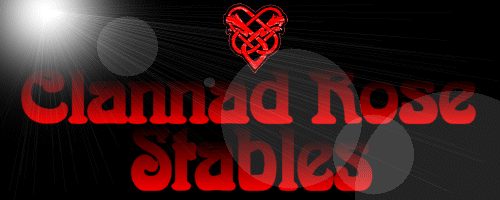
Irish Tinkers/Gypsy Vanners/Coloured Cobs
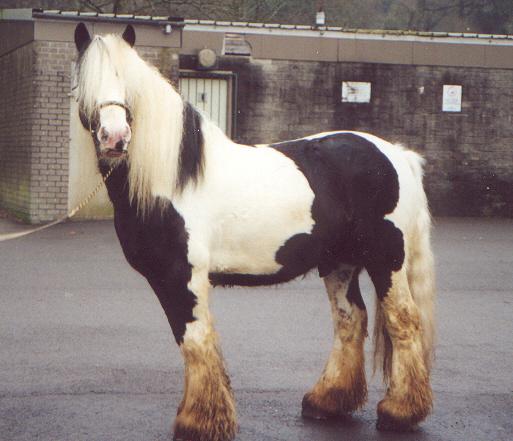
Three Common Misconceptions
Regarding the Irish Tinker/Gypsy Vanner/Coloured Cob Breed/Type:
 All of these horses represented in the US, UK, and abroad as being Irish Tinkers/Gypsy Vanners were actually bred by Romany Gypsies and/or Irish Tinkers, or are descended from horses bred by Romany Gypsies and/or Irish Tinkers. All of these horses represented in the US, UK, and abroad as being Irish Tinkers/Gypsy Vanners were actually bred by Romany Gypsies and/or Irish Tinkers, or are descended from horses bred by Romany Gypsies and/or Irish Tinkers.
 Irish Tinkers and Romany Gypsies are the same cultural group. Irish Tinkers and Romany Gypsies are the same cultural group.
 Lack of "papers" (pedigrees, etc.) negate these horses as either a breed or a type; they are simply "mutt" or "grade" horses which people are attempting to market as high dollar mounts based on fairy stories concocted based on the gypsy mythos. They are a completely new marketing scheme with no basis in fact. Lack of "papers" (pedigrees, etc.) negate these horses as either a breed or a type; they are simply "mutt" or "grade" horses which people are attempting to market as high dollar mounts based on fairy stories concocted based on the gypsy mythos. They are a completely new marketing scheme with no basis in fact.
|
Irish "Tinkers"/Travellers vs. Romany "Gypsies"
To understand these horses, as either a breed or a type, it is necessary first to rid one's self of any misconceptions regarding the people who are credited with their breeding. The most common misconception is that the Irish Travellers (or "Tinkers" as they are called colloquially) are the same as the Romany Rye (or "Gypsies"); that they are merely a group of Romany who happen to reside in Ireland. This is profoundly untrue.
The Irish Travellers ("Tinkers") come from a completely different cultural root and have a much different history from the Romany Rye ("Gypsies"). The Tinkers (which is actually a derogatory term coined by outsiders as a reference to their main source of income: the tin trade, and knife-smithing) are traced in historical documentation back at least to 400 A.D. (5th Century). It is believed that they may have originally been itinerant Druids and bards, displaced by the coming of Christianity to Ireland. The Romany, on the other hand, trace their origins back to the Indian subcontinent. Irish Travellers share a distinctive language (common dialects include Shelta, Gammon, and Cant), just as do the Romany (although the linguistic patterns of these languages share in common only that they have a certain Indo-European root. For those interested, Gaelic itself traces linguistically to an Indo-European, rather than a Latin or Germanic root.). While there certainly has, historically, been intermarriage and trade between the Travellers and the Rom, this has been minimal at best, and, at worst, there has been much in-fighting between the two groups.
Perhaps the single most important thing shared by the Travellers of Ireland and the Romany Rye is their love of horses. Both peoples based their wealth not only on the gold they wore, but the horses within their caravans. Because of this, intensive breeding programs could be found among both groups (note, however, that none of these breeding programs were recorded, as written records were frowned upon by both groups since 1) written records slow a people down or tie a people down and 2) anything written down could fall into the hands of outsiders. The strong oral tradition of the Irish Travellers also echose the long-standing oral tradition of Celtic/Gaelic people as a whole, dating all the way back to the pre-Christian Era Druids.).
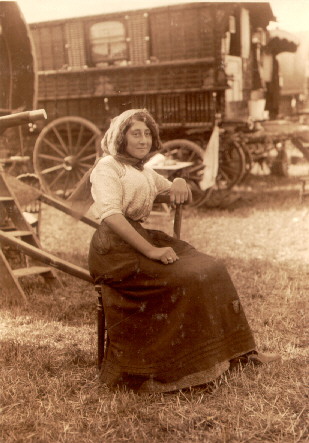
The Beauty That I Can See
When I was a child
I never had the fine things in life
I never had anything to call my own
For we were very poor
Oh, but hadn't I all the beauty
That mother nature put on earth
The different kinds of wild flowers
That no one ever planted
Oh, but the beauty of Ireland
The silver streams running beside the green fields
Covered with yellow buttercups
To make our beloved tricolour
Oh, to run through the little rivers
In my little bare feet on a summer's day
Then to look up at the blue purple mountain
Oh, sure what more could a child want
No toy could give me this much happiness
Than to come back to the camp
To look at father shoeing the horses
Paring the horses' hooves
Picking up the little pieces
Then to listen to the Travelling men
Dealing and swapping horses
Trotting the horses up and down the old tat road
To hear the noise of their hooves
Then they would slap each other's hands
Then the deal would be made
This was a beauty that money could never buy.
Nan Joyce
--From the Traveller Voices Gallery, Pavee Point Travellers' Center, Dublin, Ireland
"Dealing in donkeys, ponies and horses was widely practised and gatherings of large groups of Tinkers were common at monthly or yearly horse fairs, which were held in most towns and many villages throughout the country until the 1950s." (The Traveller Community.Notes on Traveller History, Past and Recent, and Observations on
the Current Situation in Mullingar, Co Westmeath and Generally. Michael P Flynn, Mullingar. October 2000)
Many of those opponents of Irish Tinkers/Gypsy Vanners/Coloured Cobs who are willing to believe that these horses do, in fact come from a Traveller/Romany root still oppose the breed/type as a group of mixed-up, largely unworthy, although pretty, grade or "mutt" horses, simply because of a lack of "papers" or a recorded breeding program. To make such a statement is to not only make a stab at these types of horses, but also at the Travellers themselves. Since the horse was the primary way by which these people measured their wealth, detracting from the horses is detracting from the people. Worthless or unworthy horses, quite simply, equals a worthless or unworthy cultural group of people. |
A Brief Note on the Historical Treatment of the Irish Travellers
| 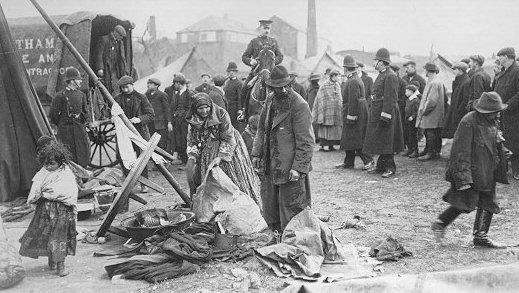
Travellers in Britain, circa 1911 | To understand the prejudices of people in the UK towards these horses as a group, it is necessary first to understand the historical prejudices held toward the people who bred them. | As early as 1911 (and earlier) and as late as the 1960's, police (gardai) were routinely called in to "evict" Traveller caravans from places where they camped. They were generally made to feel unwelcome and are still, in some areas of the UK/Ireland, not allowed to enter certain pubs, etc. (being treated very much as were Afro-Americans in the US up until the 1960s).
As late as 1963, The Report of the Commission on Itinerancy in Ireland sought not to attempt to take measures to maintain the way of life of this cultural group, but to absorb them into "normal" society. Basically, to the Travellers themselves, this equated with cultural genocide. The Minority Rights Group International report published in 1995 entitled Roma/Gypsies: A European Minority, states:
"Policies towards Roma/Gypsies [and Travellers] have always constituted, in one form or another, a negation of the people, their culture and their language. Past policies can be broadly grouped into three categories: exclusion, containment, and assimilation".
(Additions in brackets my own.)
This negativity fostered a widespread stereotype of Travellers and Romany as swindlers, thieves, and otherwise unsavory characters who could not be trusted. Therefore, anything gotten from them must be of inferior quality, and, anything gotten from them which seemed too good to be true, probably was. Supposedly, they were masters of the lie and the facade, a view which holds true even today among many who oppose these breeds/types. Most of the people who have such opinions are not aware that they are reacting from a place of prejudice, much less that these views are not dissimilar from those held by the Nazis in Germany prior to WWII. | 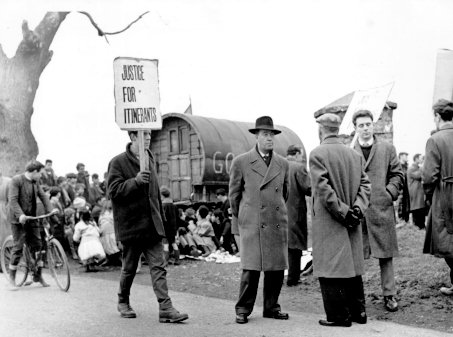
|
Secrets and Lies: The Not-So-Well-Defined History of the Irish Tinker/Gypsy Vanner/Coloured Cob
| 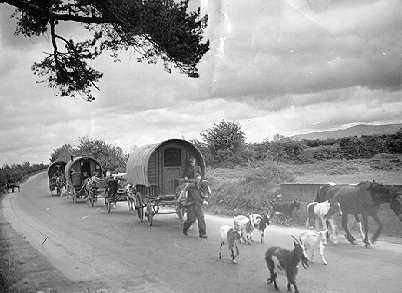
Travellers on the road to Blarney,
Circa late 1940s |
Since the cultural root of the Travellers in Ireland (which are our main focus here at Clannad Rose Stables) is shrouded in mystery, it is very difficult to say when they first began breeding horses as an important part of their livelihood, and harder still to pinpoint when those horses began to look remotely like the popular "Tinker" horses of today. | What we do know, however, is that Travellers were actively trading at horse fairs as early as 1911, and that most of the stock traded there (based on antique photographs) were of the "Tinker" type popular today. We also know that the Romany were trading at many of these same fairs, which is most likely how the Travellers came by the Vanner and Cob types now becoming popular not only in the UK/Ireland, but in the US and abroad.
According to Grant Garswood (a Romany resident of the UK who has written extensively about the Romany and their horses), there are four distinct types of Romany horse (which also seems to hold true for Tinker horses, based on photographs from yesterday and today) which are the product of breeding programs drawing from local Shires, Clydesdales, and Dales Ponies, as well as (most likely) Welsh Cobs. These types among Traveller/Romany horses are very similar to the section dilineations among Welsh Ponies. With such a wide range of types, it becomes very difficult indeed to group any animal with feathers and "pinto" coloring as simply a "coloured cob". In fact, some of these horses do not resemble cobs at all.
| 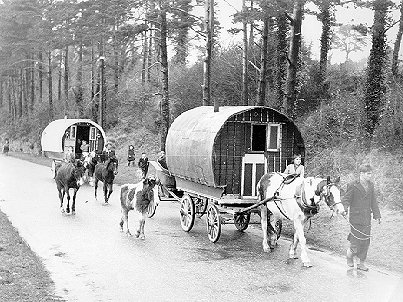
Travellers in Ireland, circa 1950 | The four sections of Romany Horse are as follows:
 Section A, Vanner: The Vanner is a very thickset well muscled cob with good conformation and well proportioned. Obvious draft horse influence. Neat well set head. An excellent heavyweight cob. Great to cross with any breed to increase bone and power. Slow and steady. Slightly one paced trot and walk. Smooth slow canter and gallop. Built for power to pull heavyweights. Action is generally quite high with slight outward flick. Slow and steady. Good stride. They are very heavily feathered, with light or multi-colored feet. They are generally piebald, skewbald, or appaloosa in coloring, and very drafty type horses. As with all "Romany" horses, they are legendary for their friendliness and their willingness to work. Section A, Vanner: The Vanner is a very thickset well muscled cob with good conformation and well proportioned. Obvious draft horse influence. Neat well set head. An excellent heavyweight cob. Great to cross with any breed to increase bone and power. Slow and steady. Slightly one paced trot and walk. Smooth slow canter and gallop. Built for power to pull heavyweights. Action is generally quite high with slight outward flick. Slow and steady. Good stride. They are very heavily feathered, with light or multi-colored feet. They are generally piebald, skewbald, or appaloosa in coloring, and very drafty type horses. As with all "Romany" horses, they are legendary for their friendliness and their willingness to work.
 Section B, Grai: The Grai is a stocky well muscled cob with good conformation and well proportioned. An excellent all-rounder that can turn its hand to most activities. Good walkers, fast trotters, smooth canter and energetic gallop. Action is generally quite high, and they tend towards a high head carriage. They have slightly less feather than the vanner, but also tend towards light or multi-colored feet. Colors are the same as for the vanner, as is temperament. Section B, Grai: The Grai is a stocky well muscled cob with good conformation and well proportioned. An excellent all-rounder that can turn its hand to most activities. Good walkers, fast trotters, smooth canter and energetic gallop. Action is generally quite high, and they tend towards a high head carriage. They have slightly less feather than the vanner, but also tend towards light or multi-colored feet. Colors are the same as for the vanner, as is temperament.
 Section C, Cob: The Section C is a stocky well muscled cob as all Gypsy types. Plainer looking than section B almost a mini-Vanner but more pony charachteristics. Slow and steady like it's larger counterpart. An excellent all-rounder that can turn its hand to most activities. Good walkers, mid-paced trotters, smooth canter and energetic gallop. Bred in profusion in Ireland. Very much in the Irish Cob mould. Action is minimal, with long strides. Feather is much like that of the vanner. Very much a mini-Vanner. Section C, Cob: The Section C is a stocky well muscled cob as all Gypsy types. Plainer looking than section B almost a mini-Vanner but more pony charachteristics. Slow and steady like it's larger counterpart. An excellent all-rounder that can turn its hand to most activities. Good walkers, mid-paced trotters, smooth canter and energetic gallop. Bred in profusion in Ireland. Very much in the Irish Cob mould. Action is minimal, with long strides. Feather is much like that of the vanner. Very much a mini-Vanner.
 Section D, Scudder: The Section D or Scudder is a finer but still well muscled cob. Originally produced by crossing one of the Gypsy types with the standardbred. An excellent all-rounder that can turn its hand to most activities. Good walkers, very fast trotters, smooth canter and energetic gallop. Bred very much for road racing amongst Gypsies. The "narrowest" of the Romany horses. Very definite Standardbred influence. Section D, Scudder: The Section D or Scudder is a finer but still well muscled cob. Originally produced by crossing one of the Gypsy types with the standardbred. An excellent all-rounder that can turn its hand to most activities. Good walkers, very fast trotters, smooth canter and energetic gallop. Bred very much for road racing amongst Gypsies. The "narrowest" of the Romany horses. Very definite Standardbred influence.
Travellers' horses tend to fall into sections A, B, and C; predominantly C.
|  | | One of the major arguments of those in opposition to the Tinker/Vanner is that the horses now being marketed in the UK/Ireland, the US and abroad as so-called Gypsy or Tinker horses are in no way, shape, form, nor fashion actually horses with a Travelling history. Unfortunately, in many cases, this may well be true. However, whether or not Gypsy King or Cushti Bok, the two most popular Vanners currently in the US, for example, were actually purchased from a "real, live gypsy" is not really all that important. In fact, whether any of these horses actually came from an actual Travellers' breeding program is relatively unimportant. What is important is that those interested in these breeds/types recognize that in furthering them, they further an ages-old tradition, and the story of a people and a culture as well. |

Irish Tinkers at Clannad Rose Stable
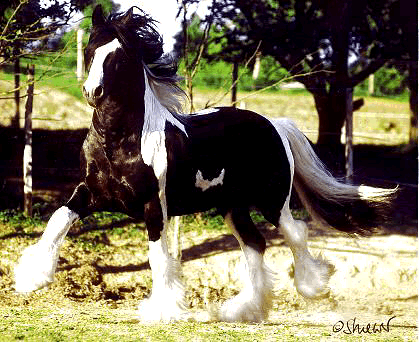
So, how does all of this reflect in the models shown and offered at stud here at Clannad Rose Stables? First and foremost, it is important to this stables' owner that her patrons understand that any attempts at showing or otherwise educating people about these horses comes not only from a love of the horses, but also from a love of the people to whom they are credited. It is the position of this stables' owner that those who detract from the breed/type also actively detract from the Traveller people. All misconceptions aside, the breed/type can be directly linked back to the Travellers, through historical and photographic evidence. Regardless of the lack of written records as far as their breeding, they are indeed a definite breed/type, easily recognized as such by those who breed them today, and especially those who have bred them for centuries.
All of the model horses represented here at Clannad Rose fall under what is regarded in the common parlance as "Irish Tinker" horses. That is, they fit into sections A, B, and C of the traditional Romany designations of type, and they all supposedly hail from Ireland. This is not to say that we unwaveringly assert that our model horses are of Traveller breeding, nor that they are the products of such breeding programs. The simple truth is, unfortunately, most of the horses--real and otherwise--available on the market today were not bred by, nor have they ever been used by, actual Traveller folk. Our model horses are, however, the same type of horses bred by the Travellers for centuries. Through our simulated breeding program, we are attempting to keep that history and tradition alive. We are not in any way attempting to claim that culture as our own. Instead, we are merely attempting to open the eyes of others to the fact that it exists, and that these horses--horses like these--have played a very important role in that culture.
| |
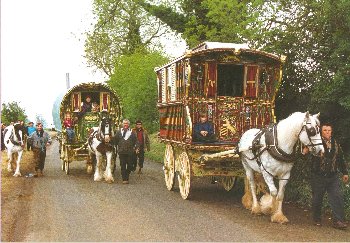
A modern Traveller convoy. | Hopefully your visit to this page has been an enlightening experience and an enjoyable one. | | If these beautiful horses, and the noble people behind them, have struck a chord in you, as they have with us, we invite you to visit the links below. We also invite you to have a visit to our stable area to view our current stock, their show records, and s/d information. If you have found this of particular interest, please feel free to link back to our site, or to share this link with others that you feel could use a bit more information on Irish Travellers, Romany Rye ("Gypsies"), or their horses. Thank you for your visit! |
 Pavee Point Travellers' Center, Dublin, Ireland Pavee Point Travellers' Center, Dublin, Ireland
 Exchange House Travellers' Service, Ireland Exchange House Travellers' Service, Ireland
 Irish Traveller Notes and Resources Irish Traveller Notes and Resources
 Gypsy Lore Collection at the University of Liverpool (Includes image and info on Travellers/"Tinkers") Gypsy Lore Collection at the University of Liverpool (Includes image and info on Travellers/"Tinkers")
 Grant Garswood's Gypsy Cob Article (and his email address) Grant Garswood's Gypsy Cob Article (and his email address) |
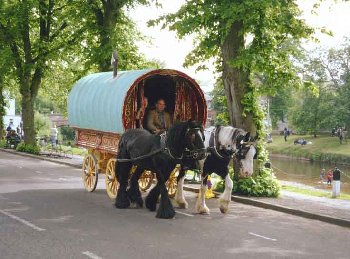
All written material herein is copyright 2002, Clannad Rose Stables, and was researched, compiled, and composed by Brandon L., my SO. Many thank yous for the eight hours plus he spent putting this page together! His tireless assistance with my stables since I have had the health problems which I am currently experiencing has enabled me to keep things running, and enabled all of you to have pedigrees done remotely on time, have new stock to view, and have all of this information at our fingertips! |


|